The AMD Ryzen Threadripper 3960X and 3970X Review: 24 and 32 Cores on 7nm
by Dr. Ian Cutress, Andrei Frumusanu & Gavin Bonshor on November 25, 2019 9:05 AM ESTPower Consumption
One of our key conclusions from our Ryzen 9 3950X review is that AMD’s TDP number on the box was now somewhat a blurred line, with the processor instead taking the ‘Package Power Tracking’ or PPT value as its true peak power consumption. This meant that for a processor to have 105 W TDP on the box, the default PPT of 142 W meant that we saw power consumption around 142 W rather than 105 W. One concern going into this review is that AMD would take a similar line with the Zen 2-based Threadripper parts as well.
Both of the TR 3960X and TR 3970X processors have a list box TDP of 280 W, which is a new ‘record’ for high power consumption in a consumer CPU. In the enterprise space we see some specialist processors break the 400W mark, but those CPUs exist in environments with a variety of cooling methods and sound isn’t much of a concern. Conversely, these AMD processors will have to live in a box under someone’s desk, so there has to be a point where the TDP is too much. Last AMD generation was 250W, this one is 280W: if we’re not there already, then this should be a practical limit. AMD of course recommends liquid cooling with a good pump and a big radiator, so anyone buying one of these processors should look into spending at least another $120+ on a good liquid cooling system.
For our power consumption metrics, we performed our usual testing: using an affinity mask to limit the cores in use, implement a high-powered workload, and then measure the power readings 30 seconds in. We take the power readings from the processor itself, using the internal registers that are designed to regulate how much the processor does a form of turbo but also regulate temperatures and so forth. This method is broadly accurate, assuming the motherboard supports the external reporting of these values, but depending on the processor family it also gives us insights into how much power is being derived from the cores individually and the package as a whole.
Here’s what we get for the 24-core 3960X:
When a single core is active, it consumes ~13.5 watts. This slowly goes down when more cores get loaded, but at 6 cores loaded we are still consuming ~12 watts per core. Even at 16 cores loaded, we’re still around 10 watts per core. This is pretty impressive. At full core loading, we’re fluctuating between 6 and 11 watts per core, as workloads get moved around to manage core loading.
From the peak power perspective, we hit 280 W with 22 cores loaded. It drops off a bit after that, like we saw with the Ryzen 9 3950X, but not by much at this time. It should be noted that as we reach these higher values, out of those 280 W, around 205 W is being used by the cores, while 75 W or so is for everything else: that means memory controllers, PCIe root complexes, and the infinity fabric. This 75 W value doesn’t vary that much, starting at 68 W even at single core load. This indicates that either IF doesn’t take much power as more cores are used, or it is on all the time.
Moving to the 3970X, and we see a similar picture:
With more cores, the power is spread around a lot more. One core loaded tops out at 13 watts, and at 11 cores loaded we can still manage above 10 watts per core. When fully loaded, we move down to as low as 3 W per core, but it does average out to around 6 watts per core. Checking the frequency at this loading and despite the 3.7 GHz base frequency, we actually have all the cores at 4.0 GHz. 32 cores at 4.0 GHz? Yes please.
The peak power metrics rise to just over 280 W when we hit 23 cores loaded and stay there, with no dip after hitting the peak. It would seem that the 3970X appears better built in that regard.
If we comment on the power between the cores and everything else, we again get a 205-210 W value for the power in the cores. This leaves 75 W or so for the rest of the chip, almost identical to the 3960X, and again this doesn’t waver much from 1 core loaded to all-cores loaded.
What will be interesting to see will be when we get the 3990X in to test as comparison. I expect that 75W value to go up – even if it goes to 100W, that leaves 180W for 64 cores, or around 3 W per core. Based on my estimates, we could be looking at anywhere from 3.0-3.5 GHz per core, which actually fits in nicely with the frequencies of the EPYC 7H12 which is also a 64-core 280W part, but for the high performance compute market.
When comparing peak power consumption to all the other CPUs in our review, as expected our new CPUs are near the top of the charts.
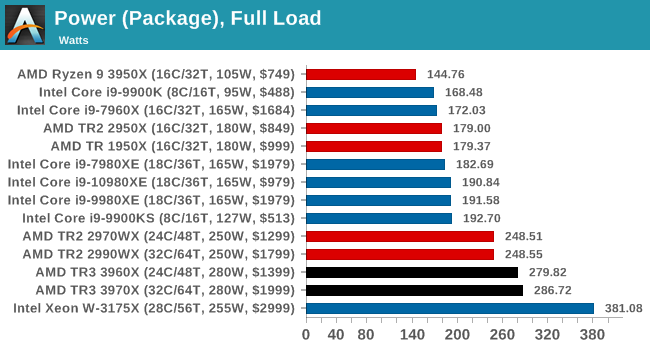
Only the unlocked 28-core from Intel peaks at a higher power, but funnily enough, that should only have a 255W TDP. So for four more cores, AMD’s peak power is still 100W below Intel’s. That’s the ‘power’ of the 7nm process node and some good quality chiplets.


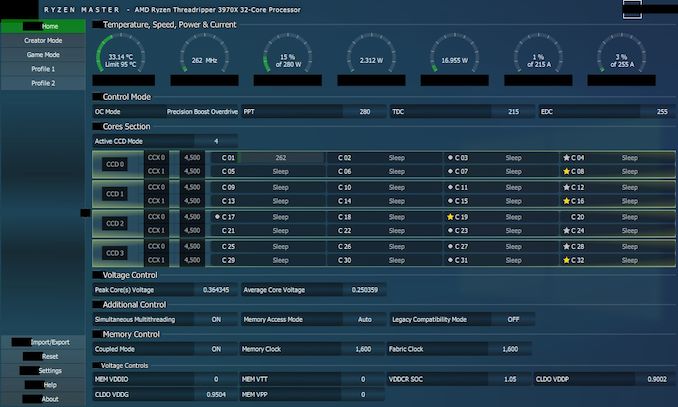
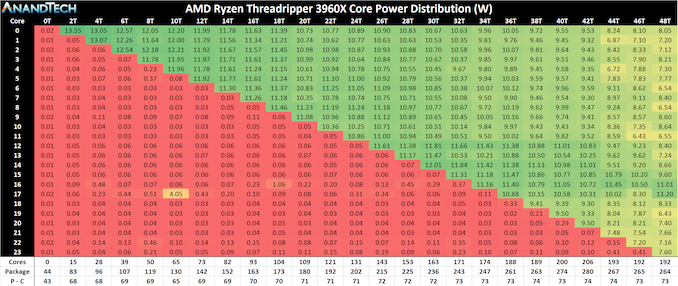
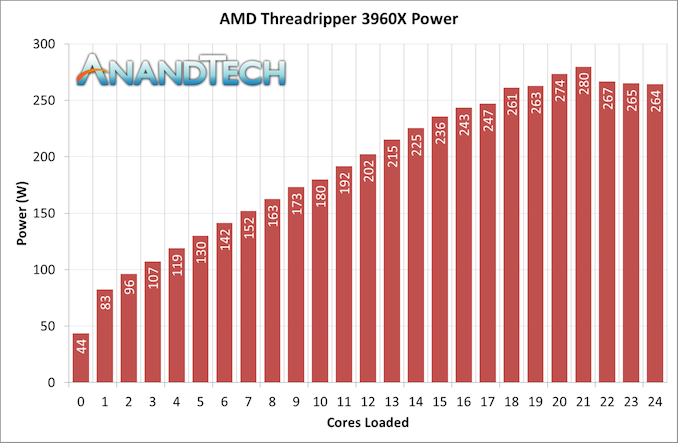
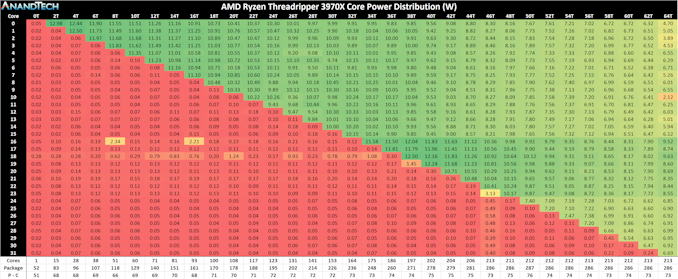
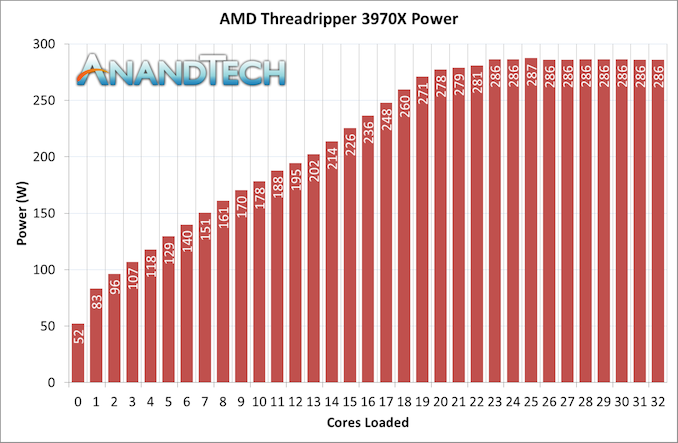








245 Comments
View All Comments
jmelgaard - Monday, November 25, 2019 - link
They also somehow forgot that AMD has been virtually invisible in the desktop CPU market for the last ~10 years, yet they managed to survive and pull this incredible victory.But for some reason, that would be unthinkable that Intel could turn things around... o.O... Pure idiocracy...
Besides, it doesn't matter if your an AMD or Intel fan, if you don't wan't both to be in the game your a pure moron, the status quo we have seen from Intel the past 10 years is exactly what we will see if they aren't both in the game. They are there to push each other, to the overall benefit for us, the consumers. If Intel really where to go out of business, then AMD would just begin to milk...
It's f****** amazing how dumb some people are...
AMD has the absolute and clear victory this time, if Intel has anything meaningful to respond with in the near future, well only time can tell...
But for now... Lets just praise what AMD has done, cheer for the amazing launch and well earned victory after what can only have been 10 long years of hard work, and hope that Intel returns... Hopefully sooner than AMD did... Or... On the other hand it's been 10 rather cheap years computer wise for me, so... perhaps I should cheer for Intel to take 10 years for a decent knockout punch in the other direction...
DannyH246 - Monday, November 25, 2019 - link
Intel will DEFINITELY return and with Jim Keller on board i'm sure in 2-3 years they will return with a vengeance. I do hope however that everyone remembers what we have been saddled with from Intel for the last 10 years...No innovation, crazy pricing, artificial market segmentation, forced new motherboard purchases every year etc etc. In short - Intel have shafted us for years and are only working like crazy now because AMD launched a rocket up their back sides. Lets hope AMD continues innovating & executing as they have been. That's not Fanboyism, its just common sense.lobz - Tuesday, November 26, 2019 - link
What gap in IPC? You think intel's Coffee Lake has a higher IPC than Zen 2? Please get your facts straight before you try to criticize other people's comments.Der Keyser - Monday, November 25, 2019 - link
AMD are really doing wonders with their ZEN2 architecture :-)But with the latest pricing of the higher end R7 and R9 and now TR I think they are making a GREAT mistake. They have decided to capitalize on having reached their target of beating Intel on performance. So prices are no longer vastly better than Intel, and we are moving into having AMD/INTEL pricing close enough not to matter to the average consumer.
This is a very short sighted decision as AMD right now has a once in a lifetime opportunity to really kick Intel in the n***. Intel’s production capability and proces node is lagging - as is their architecture. This is the time to set pricing and performance at a level were DELL, HP, LENOVO and so on are unable to ignore or downplay the AMD option because of intel funding - because that is happening now, and will continue when AMD is getting similarly expensive.
Ditch the lower end SKU’s and drop the prices on mid and high-end SKUs with 20 - 30% now and gain what AMD never had before: Market superiority to really establish their name as a household processor brand. Will all know Intel will retaliate within the next two years once their 10 and 7nm comes full online, and once that happens, AMD will once again battle with the “unproven and small player” moniker because they never got REALLY big - Getting rid of that moniker should be their second and REAL goal of this ZEN2 era. This short term money grab with the new pricing is what will keep AMD in the shadows of Intel going forward.
liquid_c - Tuesday, November 26, 2019 - link
This! So much this! I have no brand loyalty but somehow, people either chose to forget all of AMD’s mishaps (fake turbo boosts, pricing during their Athlon days, declaration of MB compatibility with future CPU gens but when time comes, they point fingers at MB vendors, etc.)liquid_c - Tuesday, November 26, 2019 - link
...or they hate Intel that much (no edit button..)Korguz - Tuesday, November 26, 2019 - link
liquid_c looks like you may be used to the way intel does things, have you seen this article :https://www.anandtech.com/show/15137/amd-clarifies...
or this one :
https://www.anandtech.com/show/14873/reaching-for-...
and what about intels TDP ratings on their cpus ?? people harped and criticized amd for the power their cpus used before zen, but, yet, when intel does the same... it seems to be ok ??
or, that just hate amd that much ....
peevee - Monday, November 25, 2019 - link
Too bad the test actually relevant to the class of CPUs, namely compilation, is gone.Also looks like some results are old, before OS and BIOS patches for security (Intel) and performance (AMD).
tony p - Monday, November 25, 2019 - link
does anyone know can I swap CPU heatsink between Socket TR4 and TR3Slash3 - Tuesday, November 26, 2019 - link
X399 and TRX40 boards use the same physical socket - heatsinks are compatible with all three generations of Threadripper.